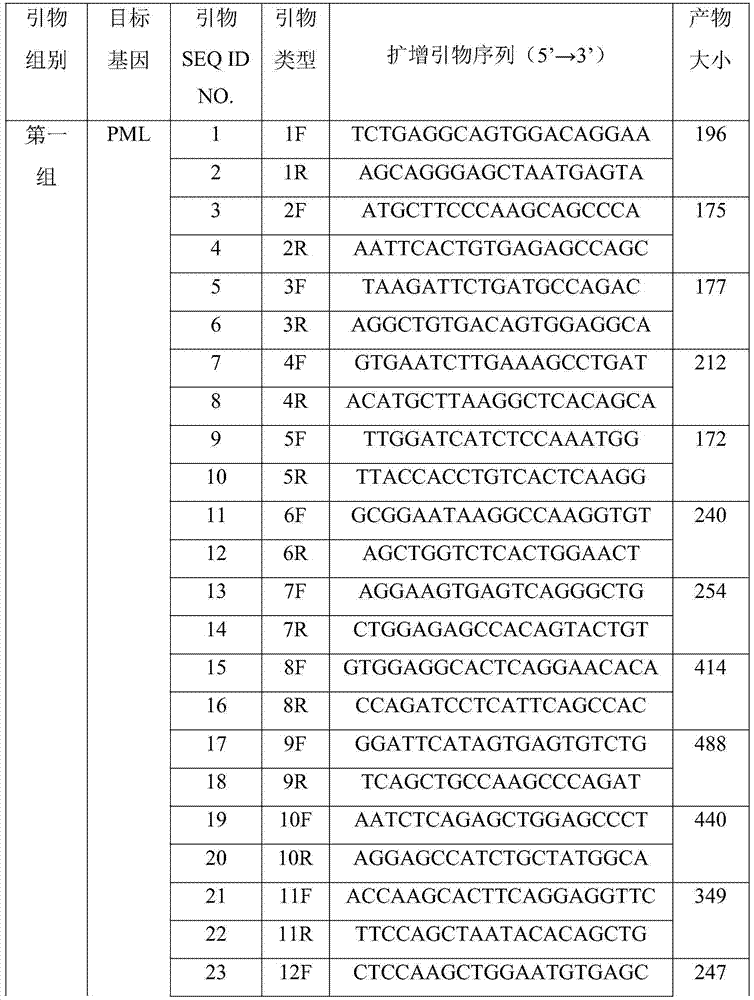PML/RAR alpha fusion gene detection kit and detection method thereof
A detection kit and fusion gene technology, which are applied in the field of molecular biology, can solve the problems of inability to type PML-RARα fusion genotype, weak signals are difficult to be detected, and affect hybridization specificity, etc., so as to improve detection sensitivity and detection efficiency. Guaranteed result specificity and sensitivity, the effect of strong specificity
- Summary
- Abstract
- Description
- Claims
- Application Information
AI Technical Summary
Problems solved by technology
Method used
Image
Examples
Embodiment 1
[0036] Embodiment 1 kit composition
[0037] The PML-RARα fusion gene detection kit described in this embodiment mainly includes:
[0038] 1. Fluorescent dye-labeled probes
[0039] The probes include a first group of probes directed at the upstream gene sequence of the L-type break hotspot of the PML gene and a second group of probes directed at the entire gene sequence of RARα. The probe is obtained by using human peripheral blood cell DNA as a template, and using 30 pairs of specific primer pairs to carry out PCR amplification reaction, and its preparation method is as follows:
[0040] 1. Design of amplification primers
[0041] The PML gene located at 15q22 and the RARα gene located at 17q21 were translocated to form a PML-RARα fusion gene. Because the breakpoints of the PML gene are different, and the breakpoint of RARα is constant (intron 2), different PML-RARα fusion gene isomers can be produced, such as L-type fusion gene, S-type fusion gene and V-type fusion gene....
Embodiment 2
[0062] Example 2 Using the kit of Example 1 to detect clinical samples
[0063] 1. Sample pretreatment
[0064] 1. Collect 1-1.5ml of peripheral blood from the patient with a sodium heparin anticoagulant tube, and centrifuge at 2000rpm for 5min;
[0065] 2. Discard the supernatant, add 5-10ml 0.075M KCl solution, pipette evenly, and treat with hypotonicity at 37°C for 30min;
[0066] 3. Add 1ml of fresh fixative solution (methanol / glacial acetic acid 3:1), pipette evenly, and let stand for 5 minutes;
[0067] 4. Centrifuge at 2000rpm for 5min, discard the supernatant;
[0068] 5. Add 10ml of fresh fixative solution (methanol / glacial acetic acid 3:1), pipette evenly, and let stand for 10min;
[0069] 6. Centrifuge at 2000rpm for 5min, discard the supernatant;
[0070] 7. Add 10ml of fresh fixative solution (methanol / glacial acetic acid 3:1), pipette evenly, centrifuge at 2000rpm for 5min, and discard the supernatant;
[0071] 8. Repeat step 7 twice, and finally add 10ul of...
Embodiment 3
[0098] Embodiment 3 The influence of the length of hybridization on the detection effect of the kit
[0099] 1. Hybridization time
[0100] The design of the probe length and dye labeling method of the kit of the present invention is the optimal solution obtained by the inventor after a large number of experiments, comparison and statistical analysis of the experimental results, which can achieve the optimal detection specificity and hybridization time. Balance can not only ensure the specificity and sensitivity of the results, but also shorten the hybridization time and improve the detection efficiency.
[0101] In order to verify the influence of hybridization duration on the detection results of the present invention, this example set up 4 experimental groups with different hybridization durations, see Table 4 for details, and the detection probes and reagents used were consistent with the kit in Example 1.
[0102] Table 4 Hybridization time
[0103] group Ex...
PUM
 Login to View More
Login to View More Abstract
Description
Claims
Application Information
 Login to View More
Login to View More - R&D
- Intellectual Property
- Life Sciences
- Materials
- Tech Scout
- Unparalleled Data Quality
- Higher Quality Content
- 60% Fewer Hallucinations
Browse by: Latest US Patents, China's latest patents, Technical Efficacy Thesaurus, Application Domain, Technology Topic, Popular Technical Reports.
© 2025 PatSnap. All rights reserved.Legal|Privacy policy|Modern Slavery Act Transparency Statement|Sitemap|About US| Contact US: help@patsnap.com



